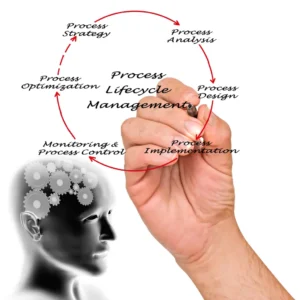
Revolutionizing Operations
The Crucial Key Features of AI Tools for Intelligent Process Automation (IPA)
At the forefront of this transformative wave are the key features of AI tools for Intelligent Process Automation (IPA), orchestrating a symphony of advancements that transcend mere automation. From machine learning algorithms that predict and optimize to the language understanding capabilities of Natural Language Processing, these features revolutionize decision-making and redefine how processes unfold.
The seamless integration and connectivity features ensure a unified data environment, while user-centric innovations like chatbots and human-machine collaboration elevate the interaction experience. Security measures and compliance features safeguard the ethical integrity of automated processes, and the scalability and adaptability of AI systems promise a future-proof approach to growth.
This exploration delves into the pivotal elements of the core of Intelligent Process Automation, ushering in an era where technology and human intelligence converge for unparalleled operational excellence.
Machine Learning Algorithms
In Intelligent Process Automation (IPA), machine learning algorithms are the linchpin, revolutionizing decision-making and enhancing operational excellence.
Predictive Analytics:
At its core, predictive analytics empowers AI tools to delve into historical data, extracting valuable insights to foresee future trends. These algorithms become invaluable guides for informed decision-making in automation processes by deciphering past patterns. Predictive analytics isn’t merely about forecasting; it’s about shaping a proactive and strategic approach to streamline operations.
Pattern Recognition:
Pattern recognition emerges as a pivotal feature in the dynamic landscape of IPA. AI algorithms keenly sift through data, identifying recurrent patterns or anomalies that might escape human observation. Efficiency soars by automating routine tasks based on these recognized patterns. The system learns from the past, ensuring that repetitive tasks are automated and optimized for maximum efficacy.
Optimization:
Continuous learning and adaptation characterize the optimization prowess of machine learning algorithms in IPA. The system evolves, aligning itself with the nuances of data and process intricacies. This adaptability translates into a perpetual cycle of enhancement, where efficiency and accuracy become the bedrock of operations. The focus is not just on automation but on continuously refining processes, ensuring they are finely tuned to deliver optimal outcomes.
Integrating these machine-learning capabilities becomes a strategic imperative in the competitive business and technology landscape. Predictive analytics injects foresight into decision-making, pattern recognition automates with precision, and optimization ensures a perpetual journey towards operational excellence.
The synergy of these features doesn’t just reduce the burden of repetitive tasks; it transforms the fabric of how processes unfold. Automation transcends execution; it becomes a proactive force, shaping outcomes and driving efficiencies. Businesses are embracing these critical features in AI tools for IPA to position themselves for today’s challenges and the dynamic demands of tomorrow. In a world where data reigns supreme, machine learning algorithms’ predictive, pattern-savvy, and ever-optimizing capabilities become indispensable allies in the pursuit of intelligent process automation.
Natural Language Processing (NLP) Capabilities
Key Features of AI Tools for Intelligent Process Automation (IPA) extend beyond mechanization, embracing the nuances of human language for enhanced decision-making and user interactions.
Text Analysis:
Text analysis is the linguistic cornerstone, allowing AI tools to decode the intricacies of unstructured data. The system extracts meaningful insights, whether it’s deciphering documents, emails, or customer interactions. This isn’t just about reading; it’s about distilling valuable information that forms the bedrock of informed decision-making. In the tapestry of IPA, text analysis is the thread that weaves understanding from the textual chaos.
Sentiment Analysis:
Understanding sentiment is not just a feature; it’s a bridge to empathy in AI. Sentiment analysis empowers systems to discern the emotional tone behind textual data. This emotional intelligence is pivotal in customer interactions, enabling the system to respond accurately and empathetically. It’s more than processing words; it’s about comprehending the feelings embedded in those words and transforming user interactions into meaningful engagements.
Language Understanding:
In the landscape of Intelligent Process Automation, language understanding is the linchpin. It’s more than recognizing words; it’s about interpreting human language with finesse. This capability facilitates seamless communication between AI systems and users. Imagine an interface that not only comprehends commands but also grasps the subtleties of human expression. Language understanding doesn’t just break the language barrier; it forms a conduit for intuitive and effective human-machine communication.
The significance of these NLP capabilities reverberates across both technical and business domains. Text analysis transforms data into actionable insights, sentiment analysis infuses empathy into responses, and language understanding establishes a profound connection between users and AI systems.
These capabilities translate into efficient data processing and a refined business user experience. Technical solution providers, on the other hand, find in NLP a toolkit that elevates the intelligence quotient of their automation solutions. In the tapestry of AI tools for IPA, NLP isn’t just a feature set; it’s a language-driven revolution, bridging the gap between technology and human communication.
Automation and Workflow Management
Key Features of AI Tools for Intelligent Process Automation (IPA) usher in a new era of operational efficiency.
Task Automation:
At the heart of IPA lies the ability to automate tasks, liberating human resources from the shackles of repetition. Whether it’s data entry, calculations, or routine processes, task automation ensures efficiency. Manual efforts are replaced by precision-driven algorithms, reducing errors and accelerating the pace of operations. It’s not just about automating tasks; it’s about elevating the overall operational landscape.
Workflow Orchestration:
In the tapestry of business processes, workflow orchestration emerges as the conductor, harmonizing various tasks into a seamless symphony. End-to-end integration becomes the hallmark of efficiency. AI tools not only automate individual tasks but choreograph the entire workflow. This orchestration ensures that each task aligns with the next, creating a fluid and synchronized operational continuum. It’s about more than automation; it’s about the artistry of orchestrated efficiency.
For businesses, task automation isn’t merely a convenience; it’s a strategic move towards optimal resource utilization. On the other hand, workflow orchestration transforms automation from a collection of tasks into a symphony of productivity.
Technical solution providers find in these features a toolkit to redefine how businesses operate. Task automation minimizes mundane efforts, freeing up resources for strategic endeavours. Automation can improve business processes by using workflow orchestration. This means that each task is meticulously planned to ensure it contributes to the overall efficiency and effectiveness of the process.
In the landscape of Intelligent Process Automation, the synergy of task automation and workflow orchestration becomes the catalyst for a paradigm shift. It’s not just about doing things automatically; it’s about orchestrating a harmonious flow that defines the essence of intelligent and automated operations.
Cognitive Automation
Key Features of AI Tools for Intelligent Process Automation (IPA) transcend routine automation, embracing cognitive capabilities for heightened efficiency.
Learning from Data:
In the pursuit of cognitive automation, the ability to learn from data becomes the cornerstone. Systems evolve, adapt, and refine processes based on new data inputs. This continuous learning ensures relevance in dynamic environments. It’s not just about automation; it’s about a system that grows smarter over time, aligning itself with the evolving data landscape.
Problem Solving:
AI tools in IPA aren’t just executors; they are problem solvers. These tools can analyze data thoroughly and make informed decisions, allowing them to navigate complex challenges strategically. It’s about more than automation; it’s about a cognitive force that tackles intricate problems head-on, transforming challenges into opportunities.
For businesses, cognitive automation isn’t just a buzzword; it’s a strategic imperative. Learning from data ensures that automated processes stay relevant in evolving business dynamics. On the other hand, the problem-solving prowess positions AI tools as strategic assets capable of navigating the complexities of modern business environments.
Technical solution providers find a toolkit in cognitive automation that transcends routine tasks. Systems that learn from data can adapt to changing situations, while AI tools that can solve problems can help tackle complex challenges.
In the landscape of Intelligent Process Automation, cognitive automation stands as the bridge between mere task execution and intelligent problem resolution. Infusing systems with the ability to learn and adapt is more than just automating processes; it’s about strategically navigating contemporary business challenges.
Data Integration and Connectivity
Key Features of AI Tools for Intelligent Process Automation (IPA) hinge on robust data integration and connectivity.
Data Aggregation:
Data aggregation isn’t just about gathering information but crafting a comprehensive mosaic from diverse sources. In IPA, this process is the foundation for informed decision-making. By integrating data from various sources, AI tools create a holistic view that guides automation processes. It’s about more than collecting data; it’s about weaving a tapestry of insights.
API Integration:
In the landscape of IPA, API integration emerges as the linchpin for seamless connectivity. AI tools don’t operate in isolation; they are integral parts of a larger ecosystem. Through API integration, these tools effortlessly connect with other systems and applications. This ensures a smooth flow of data and communication. It’s about more than integration; it’s about fostering a cohesive and interconnected operational environment.
Data integration isn’t just a technical necessity; it’s a strategic imperative for businesses. The ability to aggregate data from diverse sources gives decision-makers a comprehensive understanding of the business landscape. API integration, conversely, ensures that AI tools operate as integral components of a unified technological infrastructure.
Technical solution providers find data integration and API connectivity the backbone of intelligent automation solutions. Data aggregation enables the creation of intelligent systems, while API integration ensures that these systems seamlessly communicate with the broader technological ecosystem.
In Intelligent Process Automation, data integration and API connectivity redefine businesses’ operations. It’s about breaking down silos and fostering a unified data environment where AI tools orchestrate operations with precision and insight. The seamless connectivity established through data aggregation and API integration isn’t just a feature; it’s the conduit for a new era of intelligent and interconnected automation.
User Interaction and Interface
Key Features of AI Tools for Intelligent Process Automation (IPA) transcend functionality, prioritizing seamless user interaction.
Chatbots and Virtual Assistants:
In the landscape of IPA, chatbots and virtual assistants emerge as user-centric allies. Their role is more than automation; it’s about enhancing the user experience. Quick responses and query resolution redefine how users interact with systems. It’s about infusing automation with a human touch, creating interfaces that are not just functional but intuitive.
Human-Machine Collaboration:
The synergy between AI tools and human operators is more than a collaboration; it’s a strategic fusion of capabilities. This collaboration ensures optimal outcomes in tasks demanding machine precision and human intelligence. It’s about breaking down barriers between man and machine, fostering an environment where both complement each other seamlessly.
For businesses, chatbots and virtual assistants redefine customer interactions. It’s not just about resolving queries; it’s about creating interfaces that anticipate and address user needs. Human-AI collaboration is most effective when treating AI tools as partners, not replacements, leveraging both strengths.
Technical solution providers find a toolkit with user-centric features to redefine how automation solutions are perceived. Chatbots and virtual assistants amplify the user experience, making automation more accessible and user-friendly. Collaboration between humans and machines allows AI tools to be leveraged as enablers, enabling superior outcomes.
In Intelligent Process Automation, the focus on user interaction isn’t just a feature; it’s a paradigm shift. It’s about creating interfaces that understand, respond, and collaborate. The integration of chatbots, virtual assistants, and human-machine collaboration isn’t just about automation; it’s about building systems that resonate with the needs and expectations of the users, ushering in a new era of user-centric intelligent automation.
Security and Compliance
Ensuring security and compliance are paramount in the landscape of Intelligent Process Automation (IPA).
Data Security:
In the age of IPA, data security is the fortress safeguarding sensitive information. Robust measures are imperative to thwart cyber threats. The focus isn’t just on protection but on compliance with regulations. We need to make sure that our sensitive data is safe and private. We must also follow regulatory rules strictly. This means strengthening the gates to our data and ensuring we keep our promises to protect privacy and comply with regulations.
Audit Trails:
Audit trails aren’t merely procedural; they are foundational in the security architecture of IPA. Detailed logs track every action performed by AI tools. This transparency isn’t just a checkmark; it’s the bedrock of accountability. It ensures that every automated action is accounted for, creating a trail of transparency that instils trust and compliance.
For businesses, data security isn’t just a technological requirement; it’s a fiduciary responsibility. Conversely, compliance is not a bureaucratic necessity; it’s a commitment to ethical and legal standards.
Data security is not just an add-on; it’s the fabric of trustworthy automation. Meanwhile, audit trails are not just records but assurances of integrity.
In the landscape of Intelligent Process Automation, security and compliance aren’t just checkboxes on a list of features; they are the ethical and operational backbone. It’s about creating systems where data is processed, protected, and actions are automated and accounted for. In a world where data is the lifeline, the key features of AI tools for IPA extend beyond efficiency; they fortify the foundation of trust, ensuring that automation is not just intelligent but secure and compliant.
Scalability and Flexibility
Key Features of AI Tools for Intelligent Process Automation (IPA) extend beyond efficiency, encompassing scalability and adaptability.
Scalable Architecture:
In the landscape of IPA, scalability is not just an option; it’s a strategic imperative. Designing AI systems with a scalable architecture that can grow vertically and horizontally is essential. This means that the system can handle an increasing amount of work or data in either direction. This scalability ensures that the system can expand as workloads and demands increase. It’s more than accommodating growth; it’s about building a foundation that seamlessly adapts to the ascending tide of demands.
Adaptability:
Flexibility is the linchpin of adaptability in the world of Intelligent Process Automation. Systems must handle current processes and be agile enough to adapt to changes. This includes shifts in business processes, compliance with evolving regulations, and integration with emerging technological advancements. Adaptability isn’t a contingency plan; it’s a proactive strategy to stay relevant in the face of change.
For businesses, scalable architecture isn’t merely about handling growth but future-proofing. Adaptability, conversely, ensures that automation solutions aren’t just tailored to the present but are agile enough to navigate the uncertainties of tomorrow.
The scalable architecture ensures that its offerings can meet the growing demands of clients. Adaptability, meanwhile, positions AI tools as partners in the evolution of business processes.
In Intelligent Process Automation, scalability and flexibility aren’t just features; they support sustained growth. It’s about building systems that don’t just meet current needs but evolve with the changing tides of business, regulations, and technology. These key features of AI tools for IPA don’t just automate processes; they future-proof operations, ensuring that the benefits of automation are not just immediate but enduring.
Table of Contents

Arindam Roy
An Automation Consultant with 25+ years of IT Experience
Related Articles
- Training and Upskilling for AI-Enabled Workforce for IPA
- Challenges in Successful Implementations of AI Tools for IPA
- Addressing Security Concerns in AI-Driven Process Automation
- Integrating AI Tools with Existing Systems for IPA
- Selecting the Right AI Tools for Your Business
- Key Features of AI Tools for IPA: Transforming Processes
- AI Tools for IPA: Revolutionizing Business Efficiency
- Benefits of Implementing AI Tools for IPA
- Understanding the Business Context of IPA
- Evolution of AI in IPA: From Rules to Industry 4.0
Conclusion
In conclusion, the business and technology landscape is witnessing a transformative era propelled by the critical features of AI tools for Intelligent Process Automation (IPA).
From the precision of machine learning algorithms to the language fluency of Natural Language Processing and the cognitive prowess of automation, these features redefine efficiency and decision-making.
Integrating data sources and seamless connectivity through APIs form the backbone of informed and interconnected processes. Moreover, user-centric advancements, including chatbots and human-machine collaboration, elevate automation and the entire user experience.
In safeguarding this technological evolution, security measures and compliance features ensure automated processes’ trustworthiness and ethical integrity. Furthermore, the scalability and adaptability of AI systems signify a commitment to sustained growth and future-proofing operations against the dynamic demands of evolving landscapes.






















